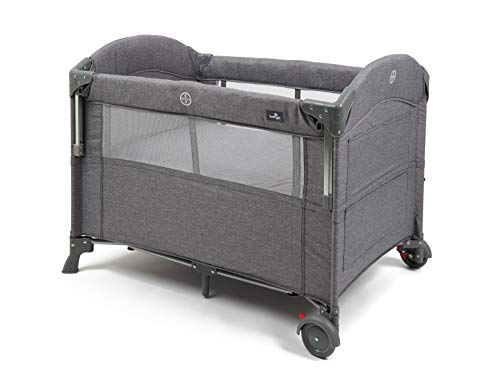Bedside Cosleeper
A bedside cosleeper is attached to your adult bed. It's safe, so long as you adhere to the CSPC safety guidelines for sleeping spaces for infants.
These guidelines are similar to crib bedding standards. Learn more about the guidelines here. The most important features to take into consideration when selecting a bedside sleeper are: Safety, Comfort, and Convenience.
Safety
In accordance with the American Academy of Pediatrics' recommendation that infants are in the same room as their parents, cosleeping (a method that is sometimes referred to as bed-sharing) has become popular with a lot of new and expecting parents. The Academy states that room-sharing is more secure than sleeping with a baby in the same bed since it reduces instances of Sudden Unexpected Death in Infants or SIDS. While the AAP does not recommend bed sharing, it does recommend that co-sleeping be done on a separate sleeping surface to limit the risk of SIDS. This is why the development of the bedside cosleeper became so crucial for many families.

A bedside cosleeper is a crib-like sleeper that attaches to an adult bed frame. The bedside cosleeper allows parents to easily monitor their little one, and it gives them the ability to move around in an adult bed while keeping their baby close to them. The best cosleepers are built using high-quality materials and meet strict safety standards. To ensure the safety of your child, look for the Juvenile Products Manufacturers Association stamp of approval. This confirms rigorous testing and quality control.
The safety of a bedside cosleeper depends on several factors, including the manner in which it is put up and connected to the parent's bed. It is essential that the bedside cosleeper is secured to the mattress of the parent in a way that does not create gaps and spaces, in which an infant could become trapped. This could pose a suffocation risk. It is crucial that the attachment system used for a bedside sleeper be tested in order to ensure that it can withstand forces that may be applied during use, for example the parent rolling on and off the sleeper. horizontal force applied to the attachment system or corners of the bedside cosleeper.
The standard for bedside cribs incorporates, by reference, the federal consumer safety standards for bassinets (16 CFR part 1218) which includes specifications for the performance of closed openings. The standard's mandatory requirements also tackle the issue of head and neck imprisonment by requiring that after the application, release 50 lbs. The standard also requires that after the release and application of 50 pounds. It is not allowed to create a gap larger than 1.0 in. ASTM's electronic Reading Room offers read-only versions of the standard.
Convenience
Many parents have resisted cosleeping because of fears of suffocation, SIDS or the "Ferberization" process that forces children to sleep alone Anthropologists have long observed that mammals and primates, as well as people living in non-Western societies, frequently coslept. This may be because infants are comforted by the familiar voice of their mother and it also helps them practice self-soothing.
The top bedside sleepers have clever design that can be attached to the side of a bed and pivots to allow easy access for feedings during the night or diaper changes. Choose a model that has adjustable feet that retract to accommodate various mattress sizes. bedside crib with changing table should also have an ample storage area to store everything your baby needs.
Choose a bedside sleeper that fits standard crib bedding, so it will be safe to use as your child grows. You might also consider an adjustable model that can transform into a play yard or deeper bassinet to last for years of use, and folds up easily for transport.
Portability
Depending on the size of your bedroom, a bedside cosleeper with wheels and/or a lightweight base might be easier to move around the house than one that has a heavy wood frame or massive base. The Babybay Bedside Sleeper, HALO BassiNest Essentia and Snoo Smart Sleeper all have great portability features: adjustable feet retract to accommodate platform beds and the legs fold inward to ensure maximum proximity to the mattress and 100% mesh sidewalls that let airflow without material covering baby's nose or mouth.
The Arm's Reach ClearVue is an excellent choice. It adjusts in 1" increments and can be used as a bassinet, or a portable bed. It also swivels, allowing the baby to be easily accessible to comfort your baby, nurse or monitor her throughout the night.
